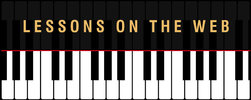|
Chords are a huge part of piano music and playing and we need to spend a good amount of time learning our chords, learning how to recognize what type of chord the music is asking us to play and all the different variety of a chord that we can play. In the written portion of this lesson we’re going to go over different types of chords, what they are called and how to play them; and then in the video portion of the lesson at the end, we’re going to go over different exercises at the keyboard that will help you master these chords in your own practice time. One of the first types of chords that all pianists learn is called Triads.Triads are made up of 3 notes. Remember how I mentioned above that we have to learn what type of chord each one is? Today we’re going to learn four types of triads and 7th chords. The four types of triads are:
Major triads always sound bright and happy. They always have 3 notes stacked on each other. The 3 notes are always the 1st, or root, the 3rd, and the 5th notes.
Minor triads are easy to identify by ear because they almost always sound sad. They are made up of 3 notes just like the major triads; the root, 3rd, and 5th notes of the scale.
Diminished triads are easy to identify because they sound ominous and kind of creepy!
Augmented triads sound a bit like diminished triads in that they share that mysterious uncomfortable kind of feeling in their sound; almost like something is about to happen.
Once you have gotten really good at knowing your triad chords both major and minor, you can then start working on chord inversions.
7th chords are another type of chord but they have 4 notes in them, not 3 like we have in triads. The 4th note in this chord is what makes it unique and have its own special sound which is dreamy and distant sounding.
Dominant 7th chords are a variation of a regular 7th chord. These chords have a distinctive blues type of sound and you will hear them a lot in that type of music.
There’s one more 7th chord that I will show you in this video plus I give lots of examples of all of these different types of chords on the piano so you can hear them as well as see the actual keyed notes in each chord. If you like my tips and lessons, you will love the courses over on my website. Whether you are a beginner looking to get a solid foundation to build on or you are looking to take you existing skills to that next level, the online music courses on my website https://www.pianolessonsontheweb.com will help you do just that.
Liyakat Bawade
7/8/2020 01:56:07 am
Chords are explained in systematic manner. Thanx Sirji
Reply
4/6/2022 01:24:30 am
Great! I don't know what would I do if you weren't her to tell us that under standing each type of chord step-by-step is the perfect strategy to sharpen our instrumental skill. My niece just got selected as part of her college choir team recently and she plans to learn how to play a piano moving forward. I'll make sure she refers to a professional so she can be well-trained.
Reply
Mike
7/5/2022 01:18:31 pm
Looking online, for a 7th you only travel 3 half steps, but the article says 4
Reply
11/22/2022 06:49:33 am
I'm interested in learning all that is need to know to become more
Reply
Leave a Reply. |
AuthorMost blogs written by Archives
June 2020
Categories
All
|

 RSS Feed
RSS Feed